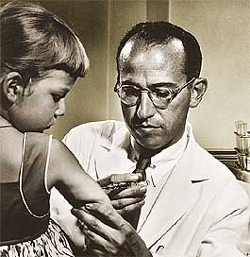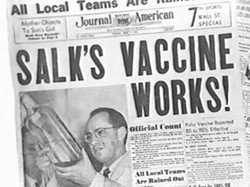 Polio was once a disease feared each summer by parents and children living in cities throughout the world. Epidemics of the disease were reported during the summer season starting in 1910. The polio epidemic of the summer of 1952 was the worst in the history of the United States. About fifty-eight thousand cases were reported with 3,145 deaths and 21,269 children left with some level of paralysis. Luckily, research was being done to develop a vaccine for this children’s illness.
Polio was once a disease feared each summer by parents and children living in cities throughout the world. Epidemics of the disease were reported during the summer season starting in 1910. The polio epidemic of the summer of 1952 was the worst in the history of the United States. About fifty-eight thousand cases were reported with 3,145 deaths and 21,269 children left with some level of paralysis. Luckily, research was being done to develop a vaccine for this children’s illness.
A project funded by the National Foundation for Infantile Paralysis (known today as the March of Dimes), an organization founded by FDR, led to the development of a Polio vaccine. Jonas Salk, an American medical researcher and virologist, went to work at the University of Pittsburgh School of Medicine in 1947. In 1948, he began a project funded by National Foundation for Infantile Paralysis to isolate the different types of the polio virus. With this project, Salk saw the opportunity to work on developing a vaccine against polio.
The first vaccine was developed in 1952. The vaccine was made from dead viruses grown in a monkey kidney tissue culture. Heat and formaldehyde were used to kill the virus. Salk favored this type of vaccine because the virus was unable to actually cause the disease.
Years of testing lay ahead to prove the successfulness and safety of the vaccine. People were impatient for something to be done and becoming increasingly fearful of the disease. Salk announced on March 26, 1953 that a small group of volunteers including himself, his wife, and children had been successfully vaccinated.
On February 23, 1954, the vaccine was tested on children from Arsenal Elementary School and the Watson Home for Children in Pittsburgh, Pennsylvania. Soon after, with more funding and support from the National Foundation for Infantile Paralysis, one of the largest medical trials in history began. Four thousand elementary children in McClean, Virginia were given the vaccinations first. The trial would eventually involve almost two million children in forty-four states. Four hundred and forty thousand students received one or more doses of the vaccine. Two hundred and ten thousand children received a placebo and another 1.2 million children received no injections and served as the control group. These 1.2 million children were checked to see if the developed polio.
 On April 12, 1955, the results of the trial were announced and history was made. A successful polio vaccine had been discovered. A campaign for vaccinating children began and the reported cases of Polio quickly fell. By 1957, there were only 5,600 cases of polio in the US and then by 1961 that number had dropped to only 161.
On April 12, 1955, the results of the trial were announced and history was made. A successful polio vaccine had been discovered. A campaign for vaccinating children began and the reported cases of Polio quickly fell. By 1957, there were only 5,600 cases of polio in the US and then by 1961 that number had dropped to only 161.
Salk never attempted to patent his vaccine. He believed the vaccine belonged to everyone. When asked why he did not want to patent and profit from his discovery he said “How could you patent the sun?”
Another researcher, Albert Sabin, developed an oral vaccine that used live viruses instead. This vaccine was tested in 1960 on 180,000 Cincinnati school children and eradicated polio in the city. Despite the wishes of the National Foundation for Infantile Paralysis, this vaccine became the one regularly used in the United States.
Together these vaccines have eradicated Polio in many parts of the world. Polio was officially eradicated in the US in 1994 and Europe has been polio-free since 2002. The spread of Polio now only continues in four countries, Nigeria, India, Pakistan, and Afghanistan.
